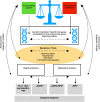Borderline personality disorder (BPD) and attention deficit hyperactivity disorder (ADHD) revisited - a review-update on common grounds and subtle distinctions
- PMID: 34229766
- PMCID: PMC8261991
- DOI: 10.1186/s40479-021-00162-w
Borderline personality disorder (BPD) and attention deficit hyperactivity disorder (ADHD) revisited - a review-update on common grounds and subtle distinctions
Abstract
Background: Overlap in symptom domains particularly in the field of impulsivity and emotional dysregulation in attention deficit hyperactivity disorder (ADHD) and borderline personality disorder (BPD) have stimulated further research activities since our last review from 2014.
Main body: Disentangling features of impulsivity in ADHD and BPD revealed that impulsivity is a feature of both disorders with patients suffering from both ADHD and BPD having highest impulsivity ratings. BPD individuals have more problems using context cues for inhibiting responses and their impulsivity is stress-dependent, whereas ADHD patients have more motor impulsivity and therefore difficulties interrupting ongoing responses. For emotion regulation difficulties the ranking order ranges from ADHD to BPD to the comorbid condition, again with the patients suffering from both, ADHD and BPD, having the most pronounced emotion regulation problems. Environmental influences namely adverse childhood events were shown to be linked to both ADHD and BPD. Traumatic experiences seem independently linked to impulsivity features. Thus, some authors point to the risk of misdiagnosis during childhood and the necessity to screen for traumatic experiences in both patient groups. Genetic research confirmed genetic overlap of BPD with bipolar disorder (BD) and schizophrenic disorders, as well as genetic overlap of BD and ADHD. A population-based study confirmed the high co-occurrence and familial co-aggregation of ADHD and BPD. Interesting questions in the field of gene-environment-interactions are currently dealt with by genetic and epigenetic research. Few studies have investigated treatment strategies for the comorbid condition, though the issue is highly important for the management of patients suffering from both disorders and presenting with the highest symptom scores.
Conclusion: Research on the different impulsivity features might point to a necessity of disorder-specific treatment strategies in the field of impulse control. Future research is needed to base treatment decisions for the comorbid condition on an evidence basis.
Keywords: ADHD; BPD; Comorbidity; Emotion regulation; Impulsivity.
Conflict of interest statement
Ismene Ditrich: No conflicts of interest.
Figures

References
-
- Polanczyk G, Lima MS de, Horta BL, Biederman J, Rohde LA. The worldwide prevalence of ADHD: a systematic review and metaregression analysis. Am J Psychiatry 2007; 164(6):942–948. Available from: URL: https://pubmed.ncbi.nlm.nih.gov/17541055/. - PubMed
-
- Lieb K, Zanarini MC, Schmahl C, Linehan MM, Bohus M. Borderline personality disorder. The Lancet 2004; 364(9432):453–461. Available from: URL: https://www.sciencedirect.com/science/article/pii/S0140673604167706. - PubMed
-
- American Psychiatric Association . Diagnostic and statistical manual of mental disorders: DSM-5. 5. Washington: American Psychiatric Publishing; 2013.
-
- Philipsen A, Limberger MF, Lieb K, Feige B, Kleindienst N, Ebner-Priemer U, Barth J, Schmahl C, Bohus M. Attention-deficit hyperactivity disorder as a potentially aggravating factor in borderline personality disorder. Br J Psychiatry. 2008;192(2):118–123. doi: 10.1192/bjp.bp.107.035782. - DOI - PubMed
Publication types
LinkOut - more resources
Full Text Sources

